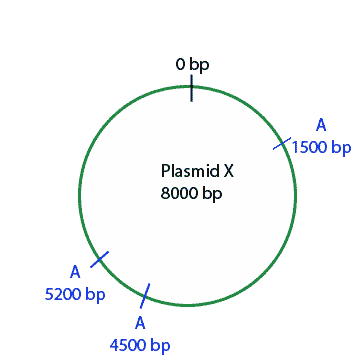A real plasmid
OK, so let’s talk plasmids. An average plasmid may be several thousand base pairs in length. So, with apologies, I will not actually be illustrating each base pair (bp) individually. Instead, I’ll just show you where base pair 0 is, and how many bp there are total.
The recognition site is also rather more complicated, so rather than write in all the bases, I’ll just show you with a line that is labeled A, for restriction enzyme site A.
Here’s an example:

If we use restriction enzyme A on this plasmid, how many pieces should we get?
How big will the shorter 2 pieces be?
(To make this problem interactive, turn on javascript!)
- Hint: One piece goes from base pair 1500 to base pair 4500
- Hint: You can find the distance between 2 points by subtracting their locations
I think I have the answer: 700 base pairs and 3000 base pairs
How big will the longest piece be?
(To make this problem interactive, turn on javascript!)
- Hint: this piece goes from 5200, up past 0, and around to 1500 base pairs
- Hint: from 5200 to 8000 is 2800 base pairs
I think I have the answer: 4300 base pairs (NOT 2800 - read the hints!)
In the following applet, you can watch a virtual gel being run -- just hit the start button, and make sure to stop it before it runs too long! Also, notice the "ladder" lane, which is composed of several fragments of known length. The ladder acts like a ruler, allowing you to measure the size of the unknown fragments.
Answers
- Why does A have 2 bands?
- Why are B bands closer together than A bands?
- Why does A+B have 4 bands?
- Why does top A band hardly move?
Copyright University of Maryland, 2007
You may link to this site for educational purposes.
Please do not copy without permission
requests/questions/feedback email: mathbench@umd.edu